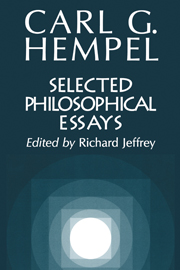Book contents
Chapter 7 - On the Logical Form of Probability Statements
Published online by Cambridge University Press: 05 June 2012
Summary
1. In the following remarks, an attempt will be made to analyze the logical form of the concept of probability and of the statements in which it occurs, and to apply the result of this analysis to some problems concerning the language of empirical science. Our considerations will be based on the modern statistical theory of probability, which is, at present, certainly by far the most satisfactory and consistent basis for a theoretical account of the concept of probability as it is actually used in empirical science as well as in everyday language.
2. According to the statistical theory, each particular probability statement refers to an infinite sequence k of events and to a property P; the probability statement then has the form: “The probability for an element of k to have the property P is p,” which, by the statistical interpretation, is equipollent to “The relative frequency of those among the first n elements of k which have the property P converges toward the limit p as n goes toward infinity.” Thus, according to the statistical theory, probability is a three-termed relation between a property (or class), a sequence, and a real number; and each particular probability statement may be given the form “Prob (P, k, p)” (“The probability of P in k is p”). Here, “p” is a real number constant with o ≦ p ≦ 1; “k” is a functor whose arguments are the natural numbers and whose values are tetrads of real numbers which may be considered as determining the spatio-temporal coordinates of events.
Information
- Type
- Chapter
- Information
- Selected Philosophical Essays , pp. 124 - 134Publisher: Cambridge University PressPrint publication year: 2000
